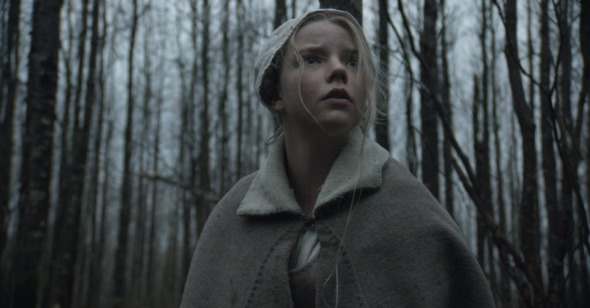Lovely, Dark, and Deep
By Michael Koresky
The Witch
Dir. Robert Eggers, U.S., A24
There is a witch. She exists, as plain and bald as the title. Though the characters’ disbelief of her existence is the crux of the film, there are few ambiguities here: we see her early, hunched and naked and involved in a horrifying but vague ritual. She is both flesh and blood and an abstract, metaphorical figure, representing the deepest fears of the people forging a land depicted as less a hopeful country-to-be than a grim forest primeval. Following a great tradition stretching from nineteenth-century American literature to twenty-first-century horror filmmaking, from Nathaniel Hawthorne’s “Young Goodman Brown” and Washington Irving’s “The Legend of Sleepy Hollow” to The Blair Witch Project and The Village, the terror of the unknown resides in the woods, a place beyond the borders of our ostensibly civilized world. In Robert Eggers’s The Witch, however, this world is so new that the boundaries between that civilized world and the untamable wilderness are exceedingly, frighteningly porous. These puritans—represented by a single family recently arrived on our shores from England—have barely settled. Their environment is dark, cruel, and fetid, a small, ramshackle farmstead surrounded on all sides by deep, dark trees and always overcast by a gloomy, forbidding sky, a constant nightmare from which the family can never awaken.
Hope for the future of American horror cinema resides in a film that has returned to the past, all the way back to the genre’s primal, literary roots. In “The Hollow of the Three Hills,” Hawthorne writes about “those strange old times, when fantastic dreams and madmen’s reveries were realized among the actual circumstances of life.” Hawthorne’s tale, which paints a short but vivid sketch of the occult in early America, embodied in a “withered hag” conducting an unheavenly rite with a wayward young maiden in a lonely mountain basin not a few miles from the world of godly men, exemplifies what makes Eggers’s film such an effective piece of regional horror. In these early stories, Hawthorne was creating a new national literature. His stories both reveled in and feared nature; viewed the American experiment itself as both worthy and dubious; extended from and critiqued its inhabitants’ puritan ideals and philosophies; and painted these people as given to crippling bouts of irrational paranoia and faith-based hysteria while also occasionally intimating, via the evocation of a supernatural world existing alongside our own, that perhaps these fears were grounded in something palpable and real. Eggers’s film carries on this Hawthorne tradition, creating a narrative in which a family’s suspicion and paranoia leads them to violently turn against one another, while at the same time confirming that the corrupting, demonic object of their fears in fact exists. It’s like a cautionary bedtime story told to seventeenth-century American tots by cruel parents tucking them in at night as the wind howls outside the door.
Yet for those who might consider this old-fashioned, rigorously unenlightened work of Puritanical horror somehow conservative (one festivalgoer used the dreaded “reactionary” to describe it in my presence), keep in mind that there’s a sly perspective at work in Eggers’s film, one that only makes itself clear in its elevating final passage. First we must get hip-deep in the emotional and physical morass of living in 1630s New England, which Eggers paints as a state of mind. Each shot from cinematographer Jarin Blaschke is awash with a grayish blue autumn chill that overlays the film with the sense of a slowly gathering storm. We barely have met our pilgrim family—sturdy patriarch William (Ralph Ineson), hardened mother Katharine (Kate Dickie), and their children—before they are thrown into doubt and turmoil. The youngest of their five, an infant, suddenly disappears during a disturbing game of peek-a-boo with her older sister, and these already terrified, distrusting, and profoundly religious folk know in their hearts that the child was spirited away into the woods by evil forces.
Thanks to a fragmented, dreamlike early interlude taking us inside the witch’s lair somewhere in the dank dark of the forest—a masterfully eerie bit of suggestive horror reminiscent of Benjamin Christensen’s primitive 1922 Danish silent Häxan, still a cornerstone of occult filmmaking—it’s hard to doubt them. At the same time, Eggers isn't interested in absolutes. The fact of evil’s existence—and in this case its snarling, nightmarish, fleshly manifestation—doesn’t make these flawed humans justified in their response, which is to turn against one another, fearing that the devil has infected all of them, especially, once the finger-pointing starts to fly, cherubic eldest daughter Thomasin (Anya Taylor-Joy). Imagine Arthur Miller’s The Crucible recast as a work of supernatural horror, with the fantastical elements somehow not negating the central thesis: The Witch is unsettling for being both an unforgiving sociological study of humans in crisis and a confirmation of the fears that lead us to hurt each other.
Save for the hair-raising presence of one sinister goat, forebodingly named Black Phillip, this is a drama of human interaction, of people so concerned with the state of their souls that they disregard the delicate matter of their flesh. The more time we spend with this family in their isolated home, the smaller their world seems, as though the walls are closing in around them. This is a deliberately paced film, of slow zooms, of camera drifts, of tortured silences. Eggers has said he was as inspired by the work of Ingmar Bergman as more obvious reference points like The Shining, and one can feel a debt to the Swedish master throughout, the film’s anguished battles of body and spirit set in claustrophobic spaces recalling such titles as The Silence, Persona, and Hour of the Wolf. Of course Bergman never closed a film with such an ecstatic confirmation of the presence of the supernatural as Eggers does here. Nevertheless, any Bergman lover might appreciate this witty and subversive climax, which provocatively points to a possible escape from the terrors of puritanical Americana.
